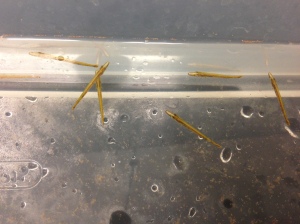After two days at sea, we went into port in Clayton, New York, where we got to walk on land for the first time since first departing Youngstown. Our day began right after breakfast with a visit to the Thousand Islands Biological Station, staffed by researchers from SUNY College of Environmental Science and Forestry. We broke up into small groups and were ferried from the Clayton dock to Governor’s Island, where the station is located.
Dr. John Farrell got us started with a lecture providing an overview of the St. Lawrence River water system. We learned the history of the region and the impact of the St. Lawrence Seaway (the shipping channel that runs parallel to the river) on the ecosystem. We were surprised to realize that invasive species in the water system include the viruses and bacteria that travel with other species, such as the zebra and quagga mussels. As a result, one species can actually introduce up to seven different invaders!
After lining up by height and breaking into four groups, we visited several different modules on the island: fish spawning, wetland floral biodiversity, local freshwater organisms, and the history of the St. Lawrence River System.
At the fish spawning module, we learned about some of the native species of fish in the river system, including muskellunges and channel catfish. It was a very hands-on station, as we got to pet a catfish! The two graduate students in charge of this station shared their work in helping to improve the struggling muskie population. They recently released 5,200 juvenile muskies into the river. It was incredible to realize that something so small can grow to be such a large animal!


Dr. Farrell led the module on wetland floral biodiversity, showing us different native and invasive plant species. This was another hands-on station, with teachers holding and smelling different algae and cattail samples. He taught us that the way to identify non-native cattail species is by examining the flower portion of the plant. Non-native cattails have a gap between the male and female parts of the flower. The freshwater organisms module gave us the opportunity to look at living samples, including several larval and adult insects, minnows, snails, and microscopic plankton.
Dr. Michael Twiss, from Clarkson University, spoke to us about his work on the St. Lawrence River. He focused on the history of the St. Lawrence Seaway, especially the social and political development of the area. What really struck us was that everyone at TIBS, including the undergraduate students, was very passionate about what they were doing and were very willing to answer any questions we threw at them!
We had a few hours in Clayton to eat lunch and explore the town. Several of us chose to visit the Antique and Classic Boats Museum. Others visited the Thousand Island Historical Museum and the Muskellunge Hall of Fame. Then it was back on the boat for a riveting presentation by Lee Willbanks, the Upper St. Lawrence Riverkeeper. He t0ld us why updating the water management plan from the 1950s and 1960s is so crucial to preserving the vitality of the river system.
Following dinner, the boat left port and we returned to Lake Ontario, where we resumed water sampling!
-Posted by Alex Stavropoulos, Laura Tedesco, and Alex Valencic


